Autism Bulletin Board Ideas
Have you ever wondered how bulletin boards can be used to create a more inclusive environment for individuals with autism?
The power of visual displays goes beyond just decoration; it can be a tool for education, awareness, and understanding.
In this discussion, we will explore various creative ideas that not only catch the eye but also promote empathy and support for those on the autism spectrum.
Join me as we uncover the impact of these bulletin board designs and how they contribute to a more inclusive and diverse community.
Key Takeaways
- Use vibrant visuals and engaging displays to promote autism awareness.
- Incorporate educational resources and communication tools for enhanced learning.
- Showcase famous individuals with autism to highlight diversity and capabilities.
- Implement self-regulation and coping strategies for well-being and success.
Colorful Visual Displays
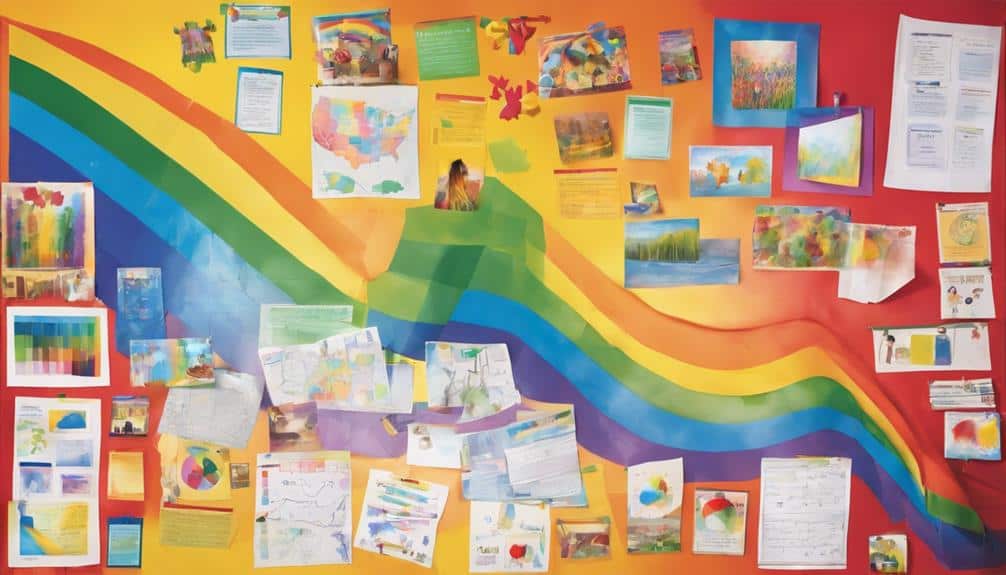
When creating bulletin boards to showcase autism awareness, I always aim to infuse them with vibrant colors and engaging visuals that draw people in and spark curiosity. As I design these awareness bulletin boards, I understand the importance of using visual aids effectively. Bright and colorful displays not only capture attention but also convey positive messages, creating a welcoming atmosphere for all viewers.
By incorporating images, symbols, and graphics, I enhance the visual appeal of the bulletin boards while effectively conveying information about autism. These colorful visuals play an essential role in promoting awareness, understanding, and acceptance of autism in educational settings. Utilizing a variety of colors and designs makes the bulletin boards visually stimulating and memorable for those who interact with them.
Through these colorful visual displays, I aim to create an environment that encourages learning and empathy, fostering a sense of inclusivity and support for individuals with autism. The vibrant colors and engaging visuals serve as powerful tools for spreading awareness and promoting acceptance.
Educational Resource Posters
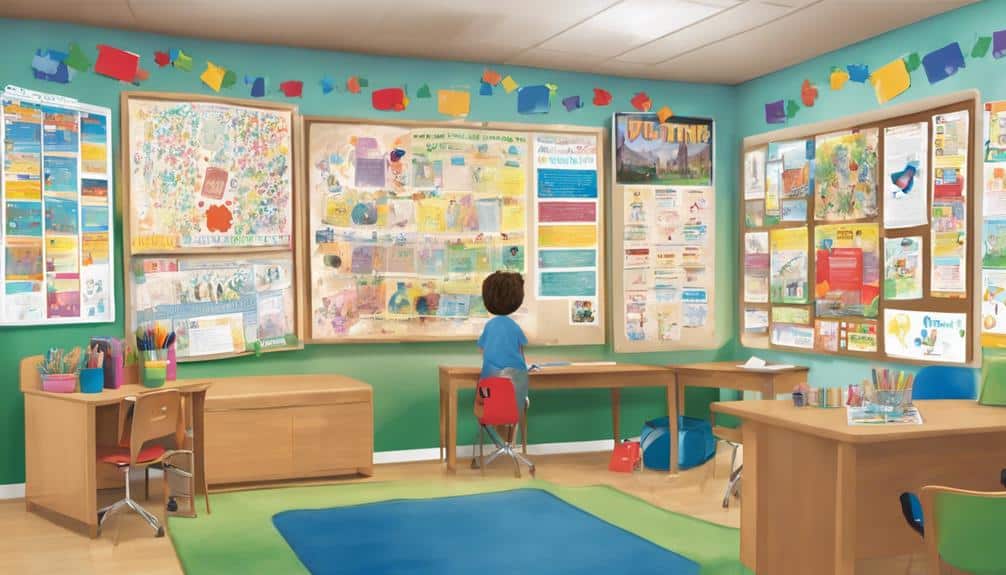
Educational resource posters play an important role in enhancing students' learning experiences by providing valuable visual support and reinforcement of key educational content. These posters are essential tools in educational settings and are especially beneficial for students with autism. Here are four reasons why educational resource posters are essential for creating an inclusive and supportive learning environment for students on the autism spectrum:
- Visual Support: Educational resource posters offer visual support that helps students with autism better understand complex concepts by providing a clear and structured visual representation.
- Information Retention: The visual nature of these posters aids in information retention, making it easier for students with autism to recall and apply what they've learned.
- Enhanced Engagement: By incorporating visually appealing posters, educators can increase student engagement and participation in classroom activities, creating a more interactive learning experience.
- Reinforcement of Key Concepts: Educational resource posters reinforce key educational content, serving as constant reminders of important information and promoting continuous learning.
Famous People With Autism
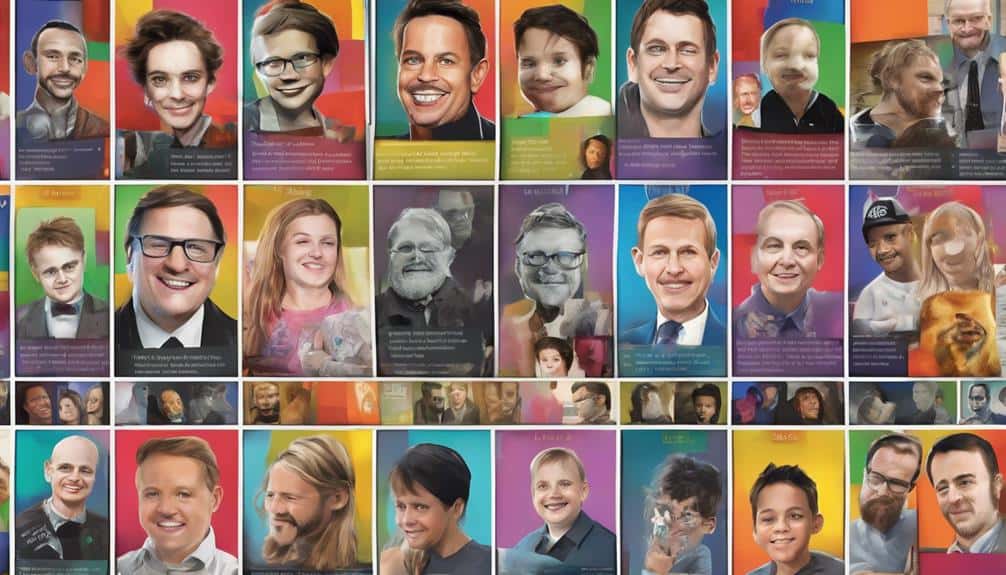
Famous individuals with autism, such as Temple Grandin and Dan Aykroyd, have greatly impacted various fields with their talents and contributions, showcasing the diversity and capabilities of people on the autism spectrum. These remarkable individuals, including Daryl Hannah and Satoshi Tajiri, have defied stereotypes and excelled in their respective fields, bringing awareness to the unique strengths that individuals with special needs possess.
Temple Grandin, known for her work in animal behavior, has revolutionized the livestock industry with her innovative designs and understanding of animal psychology. Dan Aykroyd, a celebrated actor, has entertained audiences worldwide with his performances. Daryl Hannah, an actress and environmental activist, uses her platform to advocate for important causes. Satoshi Tajiri, the visionary behind Pokémon, has captured the hearts of millions with his creative genius.
Autism Awareness Month Decor
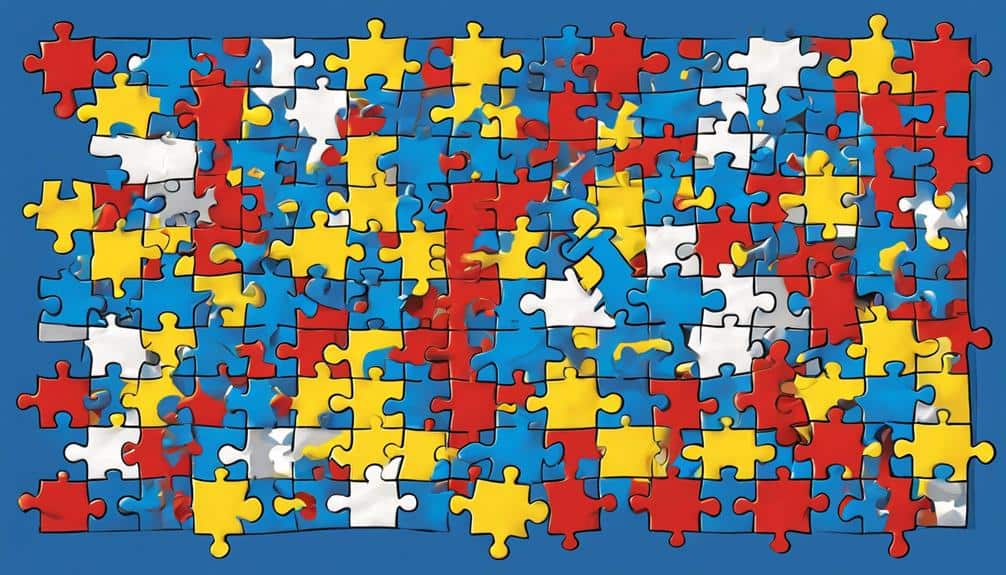
I love how Autism Awareness Month decor often features colorful puzzle pieces and sensory-friendly displays. These elements not only create visually appealing bulletin boards but also help to symbolize the complexity and uniqueness of individuals with autism.
Incorporating such designs can truly make a difference in spreading awareness and understanding throughout the community.
Colorful Puzzle Pieces
Colorful puzzle pieces, symbolizing the intricate and unique nature of individuals with autism, are a powerful visual tool for promoting awareness and acceptance during Autism Awareness Month.
- Engaging Symbolism: The puzzle pieces serve as a meaningful representation of the diverse spectrum of autism.
- Conversation Starters: They spark discussions and increase understanding about autism within schools and communities.
- Inclusive Atmosphere: Incorporating puzzle pieces into bulletin board displays fosters a welcoming environment for everyone.
- Support and Advocacy: Featuring colorful puzzle pieces in decorations demonstrates solidarity with individuals on the autism spectrum and advocates for inclusivity and acceptance.
Sensory-Friendly Displays
Creating a sensory-friendly atmosphere through thoughtful design choices is essential for fostering inclusivity and support for individuals with autism during Autism Awareness Month. Sensory-friendly displays on bulletin boards play a vital role in providing a calming and inclusive environment for individuals with sensory sensitivities.
By incorporating soft colors, tactile elements, and minimal visual clutter, these displays aim to reduce sensory overload and create a supportive atmosphere. Interactive features such as textured fabrics, velcro pieces, or sensory fidgets offer hands-on engagement opportunities.
Designing bulletin boards with sensory-friendly principles not only enhances accessibility but also promotes inclusivity in educational settings. These displays serve as a visual representation of understanding and support for individuals with autism, making them feel valued and welcomed during Autism Awareness Month.
Communication Tools for Inclusion
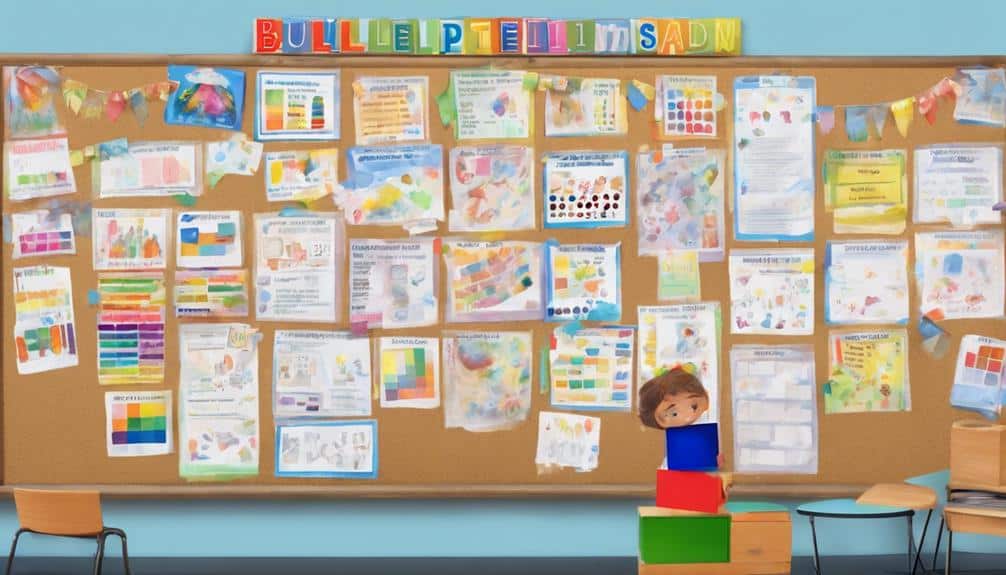
As an educator dedicated to creating inclusive environments, I understand the importance of communication tools for individuals with autism.
Visual schedules, augmentative communication devices, and social stories are invaluable resources that facilitate understanding and expression.
Visual Schedules for Inclusion
Visual schedules play an important role in fostering inclusion and enhancing communication for individuals with autism by providing a structured visual representation of tasks and activities.
- Promoting Understanding: Visual schedules offer a clear sequence of activities, aiding in comprehension and predictability.
- Reducing Anxiety: By helping individuals anticipate changes, visual schedules minimize stress and anxiety levels.
- Improving Organization: These tools enhance organizational skills, aiding in time management and task completion.
- Customization: Visual schedules can be tailored to suit individual preferences, ensuring personalized support for better engagement in diverse environments.
Utilizing visual schedules effectively can greatly benefit individuals with autism, improving their communication, behavior, and overall quality of life.
Augmentative Communication Devices
After exploring the benefits of visual schedules for individuals with autism, it becomes evident that augmentative communication devices serve as invaluable tools in promoting inclusive communication and social interactions.
Essential communication devices are vital for individuals with communication challenges, including those with autism. These tools, ranging from simple picture boards to high-tech speech generating devices, enable individuals to express their thoughts, needs, and emotions effectively. By customizing these devices to suit individual preferences, communication becomes more accessible and impactful.
Incorporating essential communication devices in daily routines enhances language development, social skills, and overall quality of life for individuals with communication difficulties. Embracing these tools not only fosters disability awareness but also facilitates learning for English and promotes inclusivity in various social settings.
Social Stories for Understanding
In crafting personalized social stories, individuals on the autism spectrum can gain valuable insights into social situations and behavioral expectations. Social stories are powerful tools that offer a structured way to teach social skills and help navigate various social scenarios.
Here are four key benefits of using social stories for individuals with autism:
- Enhanced Understanding: Social stories break down complex social situations into manageable parts, aiding comprehension.
- Improved Communication: These stories facilitate the development of communication skills by explaining appropriate responses.
- Emotional Regulation: Social stories help individuals understand and manage their emotions in different social contexts.
- Promotion of Inclusivity: By fostering empathy and positive behavior, social stories contribute to creating inclusive environments for individuals with autism.
Self-Regulation and Coping Strategies
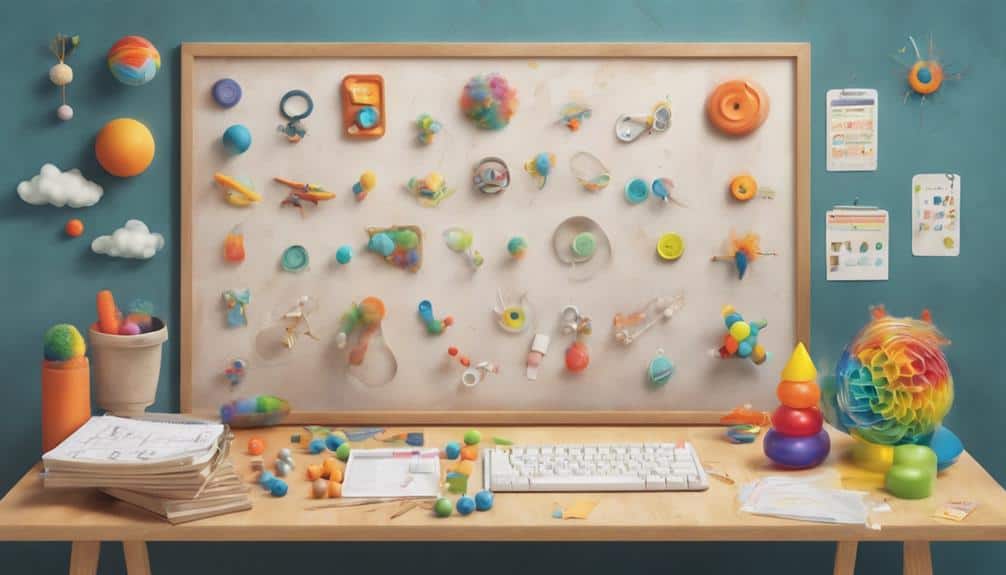
Self-regulation and coping strategies are important tools for individuals with autism to effectively manage their emotions and behaviors. These skills play a key role in helping individuals navigate their daily lives with greater ease and comfort.
By incorporating strategies such as deep breathing exercises, visual schedules, sensory tools, and social stories, individuals with autism can learn to regulate their responses in various situations. Teaching self-regulation not only aids in reducing anxiety and improving focus but also empowers individuals to handle challenging scenarios more adeptly.
Coping strategies like mindfulness techniques, break cards, and calming corners provide individuals with autism valuable tools to self-soothe and regulate their sensory experiences. These techniques offer a sense of control and comfort, enabling individuals to better cope with overwhelming stimuli.
Implementing these strategies both at home and in educational settings can significantly enhance the overall well-being and success of individuals with autism, fostering a supportive environment for their growth and development.
Bulletin Board Decor Ideas
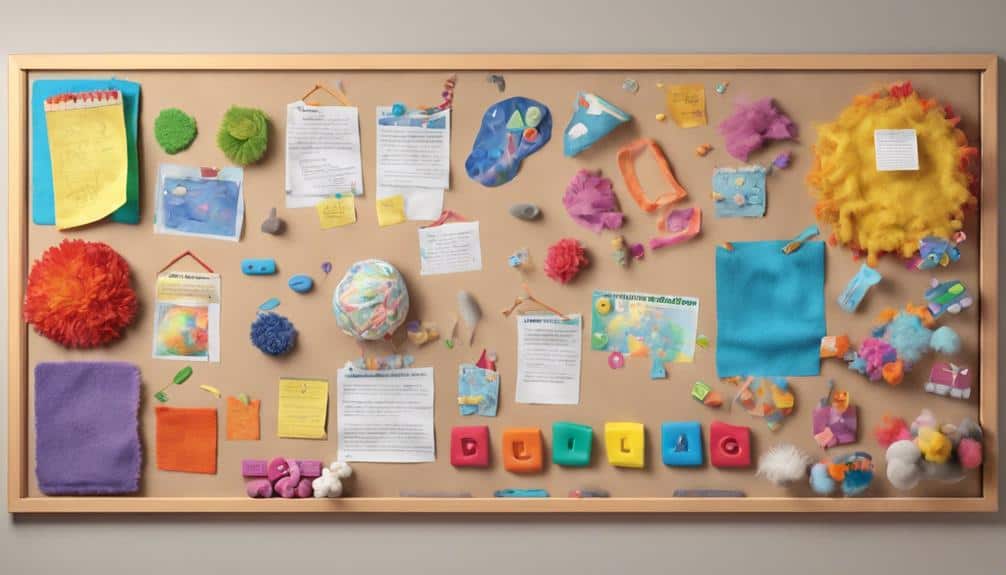
Exploring the colorful world of bulletin board decor ideas for autism awareness can spark creativity and foster a sense of inclusivity and understanding in schools and communities alike. When it comes to creating bulletin boards that promote autism awareness, here are some ideas to ponder:
- Theme Selection: Opt for themes like 'Life Is Beautiful' or 'Shine a Light on Autism Awareness' to convey powerful messages visually.
- Creative Displays: Use handprints, unique designs, and vibrant colors to craft visually appealing displays that draw attention and educate about autism.
- Community Involvement: Encourage various clubs and organizations to contribute their creative ideas for bulletin board designs, promoting a collaborative effort towards inclusivity and understanding.
- Student Engagement: Engage students, teachers, and staff in the design process to create a supportive environment that embraces and celebrates individuals with autism.
Frequently Asked Questions
What Every Autism Classroom Needs?
In every autism classroom, sensory tools and visual schedules are essential. These supports create a comfortable and structured environment that enhances understanding and independence, helping students thrive. Trained staff are vital for meeting diverse needs effectively.
What Should Be Put in the Bulletin Board?
When setting up a bulletin board, I focus on visual supports and communication tools to aid understanding. Sensory regulation items like textures and colors are key. I also emphasize social skills resources for inclusive interaction.
What Is the Goal of Autism Speaks?
The goal of Autism Speaks centers on autism advocacy, increasing awareness, and supporting research funding. They aim to provide resources, services, and support for individuals and families affected by autism, promoting understanding and inclusivity in society.
How Does Autism Speaks Help Families?
Autism Speaks provides families with a wealth of support resources, including toolkits and guides, to navigate the challenges of autism. Their awareness campaigns and advocacy efforts at all levels aim to improve lives.
Conclusion
As we wrap up our exploration of autism bulletin board ideas, remember that these displays are like colorful threads weaving a tapestry of understanding and support for individuals with autism.
Each poster, handprint, or inspirational quote serves as a beacon of hope, shining a light on the beauty of diversity and the power of inclusivity.
Let's continue to spread awareness, empathy, and acceptance, one bulletin board at a time. Together, we can create a more inclusive and compassionate world.







